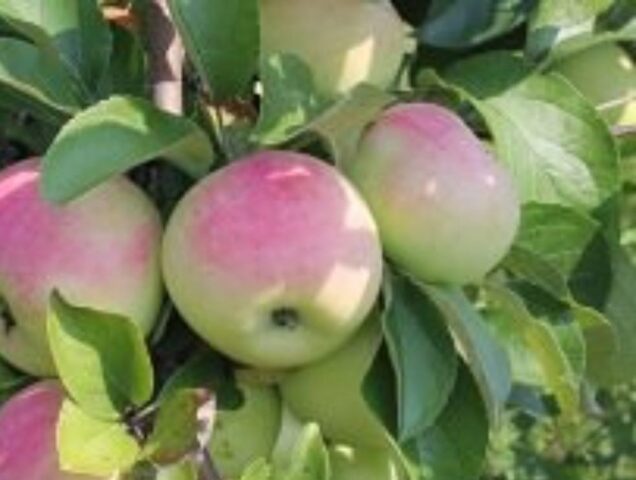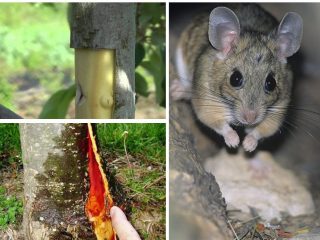Content
The Imrus apple tree is a frost-resistant, low-maintenance variety. The culture has a high immunity to scab, as it was bred using innovative technologies. Breeders included the Vf gene in the hybrid, which prevents fungal diseases from infecting the plant.
History of selection
The parents of the winter apple tree Imrus were the usual Antonovka and the hybrid form OR18T13. The variety was obtained in 1977 at the All-Russian Institute of Fruit Crop Breeding. The initiators of the culture were Yu.I. Khabarov, Z.M. Serova, V.V. Zhdanov, E.N. Sedov.
The apple tree was included in the State Register in 1996. Since 2000, the Imrus variety has been recommended for cultivation in various regions of Russia. In addition, the apple tree is zoned in six regions of Belarus.
Description and characteristics of the Imrus apple tree
The winter apple tree Imrus is a productive variety. The fruits are sweet and sour, juicy, have a long shelf life.
Wood appearance
The plant is compact.The height of the Imrus apple tree on a dwarf rootstock reaches 3-4 m, in other cases - 5-6 m. The crown of the plant is dense and moderate. The shoots are colored brown, the bark is rough. The skeletal branches are curved, their ends point upward. The leaves are medium in size and oblong in shape. Along the rim the leaf plate is wavy.
Description of fruits
The shape of apples is round. The skin is glossy, smooth, too thin. Careless handling of the fruit will lead to damage to its integrity. At the initial stage, apples are colored green. As it ripens, the skin tone changes to light yellow. The apple is covered with crimson stripes.
The weight of the fruit ranges from 130 to 180 g. The pulp is fine-grained and pale yellow. When picked from the tree, the apples taste sour; the fruits gain most of their sweetness in the winter. The pulp of the fruit contains a large amount of vitamins (including ascorbic acid), pectin and sugar.

Professional tasters rated the taste of Imrus fruits at 4.3 out of 5 possible points
Apples are suitable for fresh consumption, making juices, compotes, and purees. During testing, the juice yield was 63%.
Bloom
Imrus flowers bloom in early May. They are painted in a soft pink tone, collected in inflorescences of 4-6 buds. The variety is distinguished by abundant flowering.
Pollinators of the Imrus apple tree
The flowers are partially self-fertile. To obtain maximum yield, it is recommended to plant pollinating apple trees of other varieties nearby. The flowering of the Imrus apple tree should coincide with them in time.The best neighbors are: “Lobo”, “Golden Delicious”, “Kandil Orlovsky”, “Orlik”, “Welsey”.
Ripening time for the Imrus apple tree
Ripening times depend on the region. On average, apples are picked from the tree in mid-September. Later they begin to crumble.
Productivity
Depending on the rootstock, trees enter the fruiting phase in different ways. If these are dwarf specimens, you can expect a harvest in three years. On a seed rootstock - no earlier than five years of age. The peak of productivity occurs on an apple tree at 5-8 years, after which the intensity gradually decreases.

At the age of 4-6 years, from 30 to 40 kg of apples are collected from one tree
Frost resistance of the Imrus apple tree
Imrus can withstand frosts down to -40 ᵒC. If the temperature remains at a lower level for a long time, the tree freezes slightly, but recovers within several years.
Disease resistance
The Imrus variety has high immunity to scab. But due to the incompetent actions of the gardener, the apple tree is depleted and may be susceptible to ailments:
- Black cancer. Appears as a result of sunburn and violation of pruning rules.
- Bacterial burn is caused by bacteria at high air humidity.

It is recommended to periodically inspect the tree for the appearance of diseases in order to take timely measures
Advantages and disadvantages
Imrus fruits are environmentally friendly. There is no need to treat the tree for scab.

The Imrus apple tree can withstand temperatures down to -40ᵒС
Pros:
- excellent taste;
- increased frost resistance;
- immunity to scab;
- high yield rates;
- long shelf life.
Minuses:
- thin peel of ripe fruits;
- needs planting of pollinators;
- crumbling.
How to plant an Imrus apple tree
Imrus seedlings are recommended to be planted in April. The soil should warm up well. If you have to plant trees in the fall, the most optimal time is the end of September or the beginning of October.
A place for a tree is chosen on the sunny side of the site. Groundwater on it should not be close to the surface. The Imrus variety does not like through winds. The seedling should not be shaded by taller trees, fences or residential buildings. Fruits that ripen in the sun have a bright color and a more pronounced taste.
Before planting the apple tree, the area is dug up, having previously distributed fertilizer. At 1 m2 add 15 g of nitroammophosphate, 2 kg of peat and 8 kg of humus.
The planting hole is dug in advance. Its depth is 60 cm, width - 80 cm. A drainage layer of broken brick or gravel is laid at the bottom of the pit. This allows you to maintain the root in normal condition.
Important rules when planting an apple tree:
- The root of the plant is covered in layers of 10-15 cm. Each of them is well compacted.
- After planting, a peg is placed next to the seedling and tied.
- The root collar should protrude 5-7 cm above the ground level.
- After planting, the tree is watered abundantly.
The soil with which the seedling root is sprinkled must be fertile. It is prepared from a nutrient layer of humus and peat (2:2:1).
Rules of care
In the Moscow region, the Imrus apple tree needs special care. The climatic conditions in the region can hardly be called favorable for growing. In summer it is unbearably hot here, in winter there are frosts, and sudden changes in air temperature often occur. Sometimes it rains, sometimes you have to wait for them for a long time. The gardener will have to work hard to get a good harvest.

Regular watering is the key to ensuring that the apple tree takes root and grows.
Young trees are watered often; the soil should not dry out. Mature trees do not need a lot of water; 4-5 waterings per growing season are enough for them.
Proper pruning increases the yield and quality of apples, and also prevents the development of diseases. Pruning is carried out annually, before sap flow begins. Dry and diseased branches must be removed.
From the third year of life, the apple tree begins to be fed. In the spring, a solution of nitroammophoska is added to the root at the rate of 1 tbsp. l. product per bucket of water. Imrus also needs to be fed in the fall. Complex mineral fertilizers are suitable for these purposes.
In regions with harsh winters, it is necessary to mulch the root circle. If cracks or wounds appear on the tree, they are treated with garden varnish.
Disease and pest control
Moderate watering, timely pruning, and fertilizing will minimize the damage to the apple tree by diseases. Treating trees for ailments comes down to regular garden care. If signs of disease still appear on the Imrus apple tree, it is necessary to treat the tree with disinfectants.
The Imrus apple tree is liked not only by gardeners. It is often favored by parasites. Pest control methods:
- fight the apple blossom beetle with a lime solution. The plant is sprayed once a week;
- The apple sawfly is dangerous for the crop. It is important to regularly dig up the soil in the root circle and carry out preventive spraying with copper sulfate;
- You can fight aphids with a soap solution or a solution of soda ash.If this does not help, proceed to the use of insecticides - Twix, Confidor Maxi, Aktara.
It is not recommended to spray trees with insecticides and fungicides during fruit ripening.
Harvest and storage
Imrus fruits are removed from the tree in mid-September. Apples of this variety need time to ripen. The fruits are carefully placed in wooden boxes. If apples are injured, they lose their presentation and their keeping quality decreases. It is recommended to eat them no earlier than November. Apples acquire maximum sweetness towards the end of winter.

Under the right storage conditions (dark, cool room), the fruits retain their presentation until the end of February
Conclusion
The Imrus apple tree will provide the gardener with a supply of vitamins until the end of winter. The main thing is to properly care for it during the first four years. Indicators such as good transportability, long shelf life and high yield create demand for seedlings.








